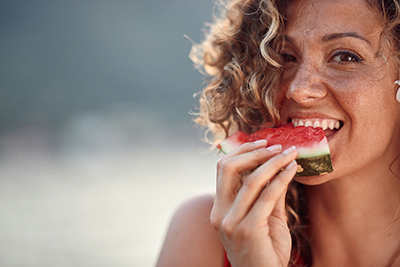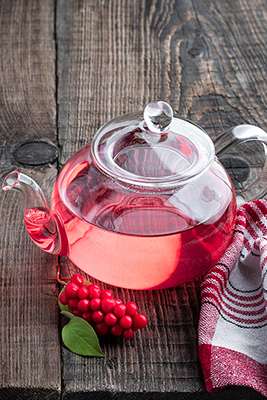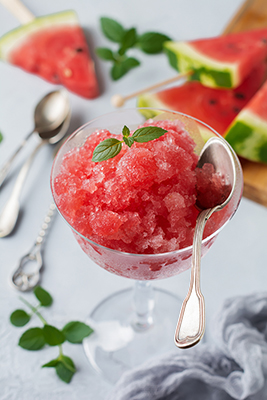Creative Ways to Drink More Water
Water intake is essential to human life; it is a simple solution that improves health and wellness. Some dislike the taste, others find it boring, but most of the time, water intake can be improved and encouraged when it’s a habit that is made obvious, attractive, easy, and satisfying.[i]
 Choose Your Vessel
Choose Your Vessel
A clear drinking vessel. The visual cue reminds you to finish your drink. There are plenty of reusable water bottles with BPA-free labels, but the truth is that most plastics contain some sort of BPA-related substitute that may be just as harmful. Glass can be heavy, so an insulated stainless-steel, double-walled water bottle with a straw is the better option for drinking on the go. At home, mason jars with measurement markings make it easy to calculate how much you are drinking.
 A pretty water carafe is more than just a decorative piece. It keeps the water within reach. Have one dedicated for your home office, dining table, or coffee table. There are sets that come with a glass cup and a lid that can be kept on your nightstand so you can start hydrating before getting out of bed.
A pretty water carafe is more than just a decorative piece. It keeps the water within reach. Have one dedicated for your home office, dining table, or coffee table. There are sets that come with a glass cup and a lid that can be kept on your nightstand so you can start hydrating before getting out of bed.
A straw. Sometimes, the action of lifting the water bottle can be an obstacle. A water bottle with a straw encourages more passive drinking so you can hydrate easily on the go.
What Kind of Water?
Tap water in Canada is safe and contains less microplastics than bottled water.[ii] However, a high-quality water filter is still recommended. Filters can be faucet-mounted, in pitchers, or a whole water system for the home.[iii] Water filters remove bacteria, leached metals, and environmental pollutants. A deeper dive into water-filtration systems would be needed to really explain what filtered water is best. Just know that using a water filter can help improve the quality of the water you are consuming.
But Water Is Just so Boring…
Water consumption in Canadian children between 9 and 13 years old has increased from 75% in 2004 to 90% in 2015 on any given day, due to the updated Health Canada Food Guide.[iv] This coincides with one glass of milk being replaced with a glass of water. Even so, 50% of adults report not drinking enough water throughout the day.[v]
For those who dislike the taste of plain water, fruit infusions provide natural flavours without the added sugars and toxins from artificial drinks and sweeteners. Just toss in a handful of fruits and fresh garden herbs for a cooling summer infusion and a hydrating “spa” experience. No straining necessary, and it looks good in the glass or carafe!
A few classic combinations are cucumber and lemon balm, triple citrus (orange, lemon, and lime), strawberry and mint, and peach or plum and mint.
 For those needing an extra boost, herbal adaptogens exist to support stress and detoxification. A summer favourite is a chilled schisandra berry tea. Schisandra chinensis contains compounds that activate liver enzymes, promote memory and cognition, and regulate the stress response. Known as the five-flavour berry—sour, sweet, salty, bitter, and pungent (spicy)—the flavour you taste correlates to a traditional Chinese medicine organ system that is needing more support.[vi], [vii]
For those needing an extra boost, herbal adaptogens exist to support stress and detoxification. A summer favourite is a chilled schisandra berry tea. Schisandra chinensis contains compounds that activate liver enzymes, promote memory and cognition, and regulate the stress response. Known as the five-flavour berry—sour, sweet, salty, bitter, and pungent (spicy)—the flavour you taste correlates to a traditional Chinese medicine organ system that is needing more support.[vi], [vii]
If preparing a fruit or adaptogen infusion is too labour-intensive, electrolyte powders, vitamin C powders, and amino-acid powders are readily available to add flavour, minimize added sugars, and give you a boost since you are already drinking water.
 Lastly, for those that are still hesitant, some fruits have an astonishingly high amount of water content. Presenting as a “triple threat” with fibre, flavour, and hydration powers, fruits like blueberries, raspberries, peaches, apricots, plums, cucumbers, pineapples, cantaloupes, and watermelons contain over 80% water! Use these to make granitas, dole whips (pureed frozen fruit), smoothies, and even fruit kebabs to keep the water intake going.
Lastly, for those that are still hesitant, some fruits have an astonishingly high amount of water content. Presenting as a “triple threat” with fibre, flavour, and hydration powers, fruits like blueberries, raspberries, peaches, apricots, plums, cucumbers, pineapples, cantaloupes, and watermelons contain over 80% water! Use these to make granitas, dole whips (pureed frozen fruit), smoothies, and even fruit kebabs to keep the water intake going.
In a nutshell, getting your daily water intake does not always need to be from plain water. The key is to consume many more hydrating solutions and foods compared to dehydrating beverages. Keep your beverage vessel filled and add a little extra boost to switch up the flavour and health punch.
See next page for two delicious drinks to enjoy this summer.
 Schisandra Berry Tea
Schisandra Berry Tea
Ingredients
- 1 tbsp. schisandra berries
- 1 litre of hot water
- Honey to taste, if desired
Directions
Steep in hot water for 15 min, then chill in fridge overnight. Consume throughout the day.
 Watermelon Granita
Watermelon Granita
Ingredients
- ½ watermelon (around 3 kg)—seedless, or seeds removed
- 1–2 limes, juice only
- Fresh mint for garnish
Directions
Cut watermelon into chunks and add to food processor or blender. Add lime juice and blend thoroughly.
Pour watermelon into a shallow freezer-proof dish. Freeze for 2 hours. Remove from freezer and scrape the surface with a fork until grainy, slushy texture. Return dish to freezer for 1 more hour.
Repeat fork scraping on the surface every hour until no more liquid remains and the entire mixture is scraped.
Serve in dessert bowls with a sprig of mint for garnish
 Dr. Patricia Wu, ND
Dr. Patricia Wu, ND
Dr. Wu is a naturopathic physician with a geriatric-focused practice in Tsawwassen (South Delta), BC. She has a special interest in heart disease, metabolic disease, and brain health (dementia/Alzheimer’s prevention).
drpatriciawu.com
References
[i] Clear, J. Atomic Habits: An Easy & Proven Way to Build Good Habits & Break Bad Ones. New York: Random House, 2018, 320 p., ISBN 978‑0‑7352‑1129‑2.
[ii] Delpla, I., C. Legay, F. Proulx, and M.J. Rodriguez. “Perception of tap water quality: Assessment of the factors modifying the links between satisfaction and water consumption behavior.” Science of The Total Environment, Vol. 722 (2020): 137786.
[iii] Escher, B.I., J. Blanco, J. Caixach, D. Cserbik, M.J. Farré, C. Flores, M. König, et al. “In vitro bioassays for monitoring drinking water quality of tap water, domestic filtration and bottled water.” Journal of Exposure Science & Environmental Epidemiology, Vol. 34, No. 1 (2024): 126–135.
[iv] Garriguet, D. “Changes in beverage consumption in Canada.” Health Reports, Vol. 30, No. 7 (2019): 20–30.
[v] Gibson, S., P. Gunn, and R.J. Maughan. “Hydration, water intake and beverage consumption habits among adults.” Nutrition Bulletin, Vol. 37, No. 3 (2012): 182–192.
[vi] Soh, R., L. Fu, W.M. Guo, W.‑G. Seetoh, and A. Koay. “Inhibitors of human bitter taste receptors from the five-flavour berry, Schisandra chinensis.” Food & Function, Vol. 14, No. 24 (2023): 10700–10708.
[vii] Sun, W., M.H. Shahrajabian, and Q. Cheng. “Schisandra chinensis, five flavor berry, a traditional Chinese medicine and a super-fruit from North Eastern China.” Pharmacognosy Communications, Vol. 11, No. 1 (2021): 13–21.

 Stores
Stores